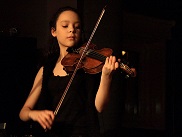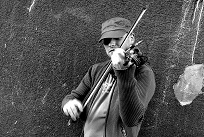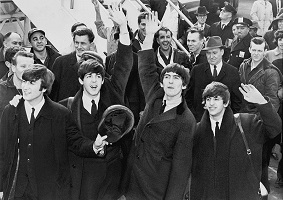Every day after school, eager children cross the doorstep of a suburban Melbourne house. It’s the home of Daphne Proietto, an exceptional piano teacher who gives lessons to children six days a week, entirely pro bono. While some kids would be more inclined to see piano lessons as a chore, these kids can’t wait. The reason? Music for them is more than just an activity.
The post Music: the language of play appeared first on OUPblog.
By Siu-Lan Tan
Sometimes you think you can explain something, and then it turns out you really can’t. This remarkable video was posted last year but only went viral in the US in the last few weeks, approaching 5 million hits in a short time. When I first saw it, I was immediately enchanted.
Click here to view the embedded video.
Dubbed by the press as ‘the Mini Maestro’ (although to be correct, she would be a maestra), the video shows little Lara Glozou with a church choir in Kyrgyzstan. She’s the young daughter of one of the choir members and often attends rehearsal.
After watching a few times, I thought I knew what might be happening. This must be an observant child who’s mirroring the actions of a conductor standing in front of the choir, interspersed with a little improvisation of her own. I thought she was a remarkable imitator, not just able to capture the conductor’s motions, but also the emotions.
But then I found another video. It shows the choir rehearsing the same song from another angle, allowing us to see the conductor’s motions of the right hand while Lara is gesturing expressively in the far right corner by the piano.
Click here to view the embedded video.
I was amazed to see that the conductor is not making the same kinds of motions as Lara after all. Even though the conductor’s gestures may be outlining the regularity of the beat and phrasing, many of Lara’s gestures and body movements—the forward lean, the hand to the chest, the sway of the body, and the dips and turns of the head—seem to be her own.
To be fair, Lara is not really “conducting.” If she were directing, her motions would come slightly before the events in the music, in anticipation of them in order to cue the choir. Her movements are more like an expression of the music. However, as an expression or sensitive interpretation of the music, I find her gestures to be remarkable. Truly extraordinary. For instance, her gestures are fewer and more prolonged during the female solo up to 0:21 (on the first video). They are a series of poses. But at 0:22 when the choir comes in, she immediately shifts to grand sweeping gestures. The variety of shapes that she forms with her hands alone express a rainbow of emotions and tone colors.
I am in awe of this little girl’s ability not only to reflect peaks and valleys in the melody of the music, and momentum of the phrases, but also the shape of the sound. For the last note of the song, she curves her left and right hands into the widest arcs for a broad final tone — a lion’s roar — rather than the kind of ending that gradually fades away.
This small child has had so little time on earth to experience falling in love, the sting of heartbreak, betrayal, triumph, grief, pain, and the rest of the great emotional topography of life. How is she able to convey the semblance of emotional depth and angst? Where is she getting her musical sensitivity? Do some young children just have an old soul?
As a former music major, I took Conducting 101. My spine was rigid, my gestures were tiny and angular. As a music student in my 20s, I had none of the intensity and theatrical weight of this little girl. More recently, I have written about how infants begin to spontaneously respond to music in bodily ways, nodding their heads and waving arms to rhythmic music once they are able to sit freely at about six months. Later, bobbing up and down with knee-bends, and spinning around in circles to music between one and two years, after they become mobile.
However, they do so for only short bursts, and most of the movements of two- and three-year-old children don’t really match the music in time (Moog, 1976; Malbrán, 2000). Although Lara is not always synchronized with the music, her deep expressive gestures capture the musical events in a broad way, even anticipating some musical moments, as she is familiar with this piece.
Little is known about young children’s interpretation of music. In one of the few studies in this area, Boone & Cunningham (2001) showed that four-year-olds can move a flexible teddy bear in dance-like fashion, to express emotion in music through movement. However the musical emotions they recognized and expressed were basic emotions (such as happiness, or sadness, or anger). What we seem to observe in Lara is much more nuanced. How is she able to capture this depth in music?
I spoke with a grown-up maestro that I greatly admire, Andrew Koehler, Music Director of the Kalamazoo Philharmonia. He said, “It’s really astonishing. Lara moves in a way that shows that she recognizes agogic accents“ (longer durations of tones, which give natural stress to music). She often reflects this with larger, more expansive motions of her arms that mark those accents.
Her gestures also capture finer details. At 0:45 to 0:47 in the first video, Koehler points out how a higher tone of greater tension resolves to a lower tone of lower tension. The toddler reflects this: “Lara leans into the music, her right hand pushing into it with a claw-like motion [capturing high tone and high tension in the music]. Then both left and right arms make downward motions as her posture goes back to an upright position again [lower tone, lower tension].”
And then there’s Jonathan Okseniuk. Here he is at three years old, appearing to ‘conduct’ a recording of the last movement of Beethoven’s Fifth Symphony in his home in Mesa, Arizona.
Click here to view the embedded video.
Even if he appears to be getting some coaxing off camera, this is a remarkable three-year-old.
Here is Jonathan again at age four, conducting a live orchestra in a rousing rendition of Khachaturian’s ‘Sabre Dance’. “This is a more challenging arena,” explains Koehler, “which would require Jonathan to anticipate what will happen in the music as opposed to simply responding to it.”
Click here to view the embedded video.
There are many other videos of Jonathan on the web, conducting Beethoven, Brahms, Mozart, and Strauss with different orchestras.
How an understanding of music blooms so early in some young ones astonishes me. This mini-maestra’s sensitive expression of music and mini-maestro’s early conducting chops have left me perplexed.
Siu-Lan Tan is Associate Professor of Psychology at Kalamazoo College in Michigan, USA. She is primary editor of The Psychology of Music in Multimedia (Oxford University Press 2013), the first book consolidating the research on the role of music in film, television, video games, and computers. A version of this article also appears on Psychology Today. Siu-Lan Tan also has her own blog, What Shapes Film? Read her previous blog posts.
Subscribe to the OUPblog via email or RSS.
Subscribe to only psychology articles on the OUPblog via email or RSS.
The post Mini maestro mystifies me appeared first on OUPblog.

By Dorottya Fabian, Renee Timmers, and Emery Schubert
Picture the scene. You’re sitting in a box at the Royal Albert Hall, or the Vienna Musikverein. You have purchased tickets to hear Beethoven’s Ninth Symphony performed by an internationally-renowned orchestra, and they are playing it in a way that sounds wonderful. But what makes this such a powerful performance?
What is expressiveness? Let’s start by looking at these images …







Do you notice what they all have in common? They are all displaying different kinds of expression. Just as facial expressions communicate different information to us, musicians playing the same piece will still produce slight differences. You can’t hear the musicians in these pictures, but they may both be playing the same piece in a way that is not exactly the same as the other group of musicians.
Click here to view the embedded video.
Click here to view the embedded video.
People say music is expressive. They usually say it is expressive of emotions and therein lays its power. But is this true of all music in all cultures and historical periods? Does it matter how it’s performed and how it’s experienced?
Philosophers, psychologists, and musicians have been pondering these questions for centuries. Over the last hundred years psychologists have contributed much to developing an empirically-based understanding of the mechanisms at play. The distinction between what may be “in the music” and what the performer “adds” became a fundamental assumption leading to various theories and definitions of “expressiveness in music performance.”
Ever since the pioneering work of Carl Seashore in the 1930s psychologists have been studying individual performers to find out “what it is that a performer brings to a piece of music.” So what is it that One Direction does when covering “All You Need Is Love” that makes their performance expressive? Are they more expressive than the Beatles are in this clip? Is it the song that is expressive or does it matter how it is performed?
For those educated in western classical music, Seashore’s working definition of what is expressiveness seems reasonable: You are listening to Beethoven’s Ninth Symphony and different orchestras and conductors make it sound more or less dramatic, uplifting, emotional, riveting. But if we pause for a moment and think of all those ever listening to this great icon of western musical culture, is it reasonable to believe that they know what is “the music”, i.e. Beethoven’s composition, and what the performers “bring to it”? What about an audience who have never experienced the piece before? How do they know what is “the music” and what is the contribution of the musician? This dilemma is even more obvious in other styles, like jazz, traditional, popular, or world music.
One, wordier definition of expressiveness in music performance is “the micro-deviations from the notated dictates of the score a performer executes while playing.” So, if the notes of a score are played literally, the piece will sound dull and inexpressive — like an old MIDI notation player, or a student playing precisely in time with a metronome. The result is a “neutral” performance, like the computer image of the face above. But is this an acceptable definition? What about musicians who do not use a music score – improvisers, people who play music by ear?
Recent empirical work has shown that listeners tend to be unable to say if the expressiveness they are hearing originates from the composition or the performance. Studying the experience of professional musicians highlights how differently they approach their performance. For them the score is never just notes on paper but already music imagined as sound. This imagination depends on their socio-cultural, historical position, personality, and education. They use metaphors and heuristics, short-cuts that package up accumulated knowledge and speeds up problem solving in preparation for and during performance. They rarely speak of specific emotions to be conveyed but conceive of music as “emotional,” “dramatic,” “uplifting,” or “turbulent,” for instance.
This is true of music and musicians of other artistic traditions, like classical Hindustani music. According to the dhrupad singer Uday Bhawalkar, “Music without emotion is not music at all, but we cannot name this emotion, these emotions, we cannot specify them.” The sentiments or emotions that we encounter in daily life become transformed into aesthetic experiences in theatre.
Empirical work in the area of jazz and popular music shows the importance of rhythm, vocal gestures, persona, and the role of technology to create meaning through sound effects. One fascinating finding regarding the culturally construed nature of what is “expressiveness in music performance” comes from a study of the Bedzan Pygmies. They live in very small communities with 40-60 kilometres distance between them and come together only for large festivities like weddings and funerals. When singing together in intricate polyphony, each singer varies his or her line at will while maintaining the overall identity of the song. For them “expressiveness” increased when they could detect more voices in the ensemble.
Expressiveness is an important part of music performance and perception, and although we have an intuitive understanding of what expressiveness in music means, as it turns out expressiveness in music performance seems too malleable and slippery to be defined in a singular way. So what is more important is to formulate the perspective of future research and discussion, to reorient our approach and reconstruct the object of investigation.
Dorottya Fabian, Renee Timmers, and Emery Schubert, are all researchers and lecturers in music psychology. Their book Expressiveness in Music Performance offers a variety of approaches to talk meaningfully about expressiveness and music within a cross-cultural context, providing disciplinary overviews, discussion papers and case studies to show that debates of importance across the humanities and social sciences can be conducted in a richly evidence-based manner.
Subscribe to the OUPblog via email or RSS.
Subscribe to only brain sciences articles on the OUPblog via email or RSS.
Image credits: (1) Guilty Face, by Barry Langdon-Lassagne, CC-BY-3.0 via Wikimedia Commons. (2) Your Smiling Face, by Sibelle77, CC-BY-SA-3.0 via Wikimedia Commons. (3) Изображение-Портреты-Михайлова Елена Владимировна, by участница Udacha, CC-BY-3.0 via Wikimedia Commons. (4) Addys Mercedes Kult 02, by Schorle, CC-BY-SA-3.0 via Wikimedia Commons. (5) Adam Romański 1, by Konrad Wawrzkiewicz (Shannon5), CC-BY-SA-2.5 via Wikimedia Commons. (6) One Direction Glasgow, by Fiona McKinlay, CC-BY-SA-2.0 via Wikimedia Commons. (7) The Beatles in America, by United Press International, photographer unknown, Public domain via Wikimedia Commons.
The post Expressing ourselves about expressiveness in music appeared first on OUPblog.










